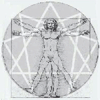“My ballet is not a ‘mystery,’” said G. “The object I had in view was to produce an interesting and beautiful spectacle. Of course there is a certain meaning hidden beneath the outward form, but I have not pursued the aim of exposing and emphasizing this meaning. An important place in the ballet is occupied by certain dances. I will explain this to you briefly. Imagine that in the study of the movements of the heavenly bodies, let us say the planets of the solar system, a special mechanism is constructed to give a visual representation of the laws of these movements and to remind us of them. In this mechanism each planet, which is represented by a sphere of appropriate size, is placed at a certain distance from a central sphere representing the sun. The mechanism is set in motion and all the spheres begin to rotate and to move along prescribed paths, reproducing in a visual form the laws which govern the movements of the planets. This mechanism reminds you of all you know about the solar system. There is something like this in the RHYTHM of certain dances. In the strictly defined movements and combinations of the dancers, certain laws are visually reproduced which arc intelligible to those who know them. Such dances are called ‘sacred dances.’ In the course of my travels in the East I have many times witnessed such dances being performed during sacred services in various ancient temples. Some of these dances are reproduced in The Struggle of the Magicians.’ More-over there are three ideas lying at the basis of “The Struggle of the Magicians.’ But if I produce the ballet on the ordinary stage the public will never understand these ideas.” Fragments: One
He told me a great deal about carpets which, as he often said, represented one of the most ancient forms of art. He spoke of the ancient customs connected with carpet making in certain parts of Asia; of a whole village working together at one carpet; of winter evenings when all the villagers, young and old, gather together in one large building and, dividing into groups, sit or stand on the floor in an order previously known and determined by tradition. Each group then begins its own work. Some pick stones and splinters out of the wool. Others beat out the wool with sticks. A third group combs the wool. The fourth spins. The fifth dyes the wool. The sixth or maybe the twenty-sixth weaves the actual carpet. Men, women, and children, old men and old women, all have their own traditional work. And all the work is done to the accompaniment of music and singing. The women spinners with spindles in their hands dance a special dance as they work, and all the movements of all the people engaged in different work are like one movement in one and the same RHYTHM. Moreover each locality has its own special tune, its own special songs and dances, connected with carpet making from time immemorial. Fragments: Two
“It is possible to experience the enneagram by movement,” he said. “The RHYTHM itself of these movements would suggest the necessary ideas and maintain the necessary tension; without them it is not possible to feel what is most important.” Fragments: Fourteen
It was a very interesting time for me. G. often came to me in Prinkipo. We went together through the Constantinople bazaars. We went to the Mehlevi dervishes and he explained something to me that I had not been able to understand before. And this was that the whirling of the Mehlevi dervishes was an exercise for the brain based upon counting, like those exercises that he had shown to us in Essentuki. Sometimes I worked with him for entire days and nights. One such night in particular remains in my memory, when we “translated” a dervish song for “The Struggle of the Magicians.” I saw G. the artist and G. the poet, whom he had so carefully hidden inside him, particularly the latter. This translation took the form of G. recalling the Persian verses, sometimes repeating them to himself in a quiet voice and then translating them for me into Russian. After a quarter of an hour, let us say, when I had completely disappeared beneath forms, symbols, and assimilations, he said: “There, now make one line out of that.” I did not try to create any measure or to find a RHYTHM. This was quite impossible. G. continued and again after a quarter of an hour he said: “That is another line.” We sat until the morning. This was in Koumbaradji Street a little below the former Russian consulate. At length the town began to wake. I had written, I think, five verses and had stopped at the last line of the fifth verse. No kind of effort could make my brain turn any more. G. laughed but he also was tired and could not go on. So the verse remained as it was, unfinished, because he never returned again to this song. Fragments: Eighteen
G.’s own work during this time, that is, from 1922, was dedicated chiefly to the development of methods of studying RHYTHM and plastics. He never stopped working the whole time on his ballet, bringing into it the dances of various dervishes and Sufis and recalling by memory the music he had listened to in Asia many years before. In this work was a very great deal that was new and interesting. Dervish dances and music were reproduced in Europe undoubtedly for the first time. And they produced a very great impression on all who were able to hear and see them. Fragments: Eighteen

